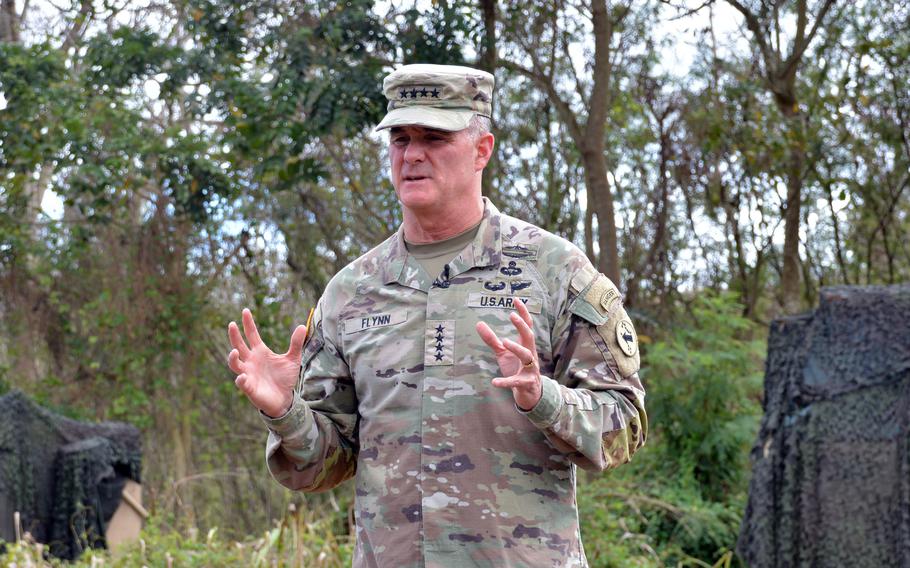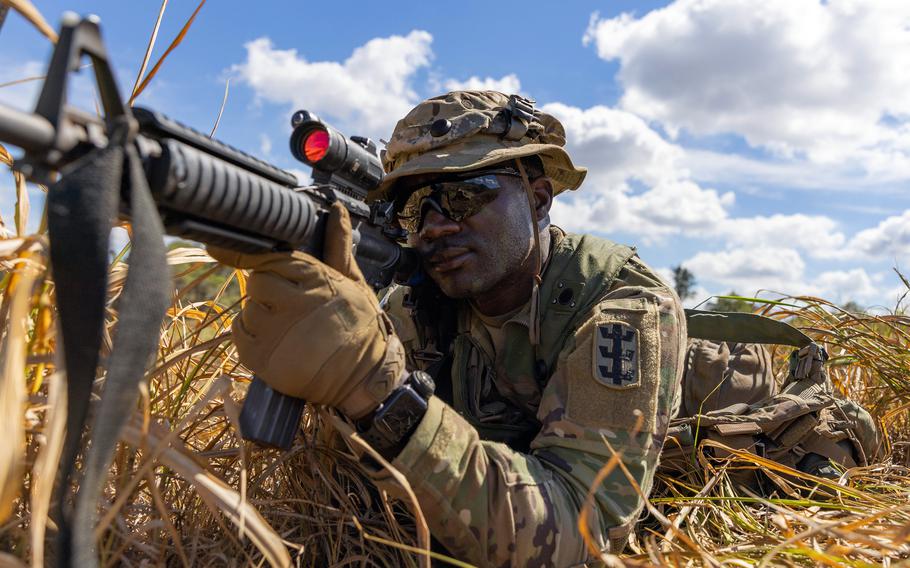
Gen. Charles Flynn, commander of U.S. Army Pacific, speaks to reporters on a training field at Wheeler Army Airfield, Hawaii, Monday, Nov. 6, 2023. (Wyatt Olson/Stars and Stripes)
WHEELER ARMY AIRFIELD, Hawaii — U.S. Army Pacific’s commander offered bad and good news about China’s rising military might Monday as helicopters buzzed overhead and trucks rumbled by him at this base on Oahu.
“What I’m seeing in the region is the irresponsible and insidious behavior of the Chinese,” Gen. Charles Flynn told reporters during a break from the massive 10-day Joint Pacific Multinational Readiness Center exercise that concludes Friday.
“That’s the bad news,” he said. “The good news is that I’m also seeing an increase in multilateral and multinational exercises tenfold.”
That would first and foremost include this readiness exercise, which is taking place on Oahu, the Pohakuloa Training Area on the Big Island of Hawaii and on Palau in Micronesia.
The training is focusing on the Hawaii-based 25th Infantry Division’s 3rd Brigade Infantry Combat Team, but the 5,100 personnel participating also include airmen, sailors and Marines.
Flynn ticked off a list of once low-key bilateral Army exercises with partner nations that are now huge in scope.
Talisman Sabre in Australia was once an army-to-army exercise between the U.S. and that close ally. “Now you have 15 nations, 30,000 people,” he said.
Garuda Shield in Indonesia was once a bilateral army-to-army affair, but earlier this fall it had 6,000 participants from 14 nations, Flynn said. The Yama Sakura drills in Japan now include soldiers from four nations, he added.
“What we’re doing here is integrating and binding together the joint and multinational forces in a way where our interoperability, our readiness, our confidence is enhanced,” Flynn said of the Hawaii exercise, which includes troops from Thailand, Indonesia, New Zealand and the United Kingdom.
The growing participation and interest in joint multinational training “enables our partners and allies in the region to defend their territorial integrity, protect their national sovereignty, protect their people and protect their resources,” he said.
Interoperability for the military is the ability of a country’s armed forces to use another country’s training methods and military equipment.
China has created an arsenal that is primarily designed to defeat air and naval power through anti-access strategies, Flynn said.
It is not designed to “find, fix and finish” the kind of mobile and distributed land forces that U.S. Army Pacific would deploy in an archipelagic environment during a conflict in the region, he said.
“That has enormous deterrence effect,” he said.

A soldier shoulders a rifle at Schofield Barracks, Hawaii, Nov. 2, 2023, during the Joint Pacific Multinational Readiness Center exercise. (Tristan Moore/U.S. Army)
The Joint Pacific Multinational Readiness Center at Schofield Barracks, Hawaii, provides personnel and equipment that rival the kind of realistic combat training soldiers would get at the Joint Readiness Training Center at Fort Johnson, La., or the National Training Center at Fort Irwin, Calif., but with less hassle.
Sending soldiers and equipment to those stateside sites has not been optimal, Flynn said.
“We would pack up an entire division’s worth of equipment and sail through the Panama Canal to Louisiana,” he said. Soldiers were separated from their equipment for months as it was sent to the training center and then sent back.
“And we just cannot afford to be going out of this region,” he said.
“For example, if something were to happen, I would cancel this in a second,” Flynn said, snapping his fingers toward the training surrounding him.
“If we’re in the Panama Canal and something happens, I just took options away from the National Command Authority and the combatant command,” he said.
“I don’t want to do that,” Flynn added. “I want to give them options.”